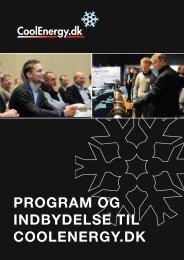Air-Source vs. Water/Ground-Source Heat Pump Systems ...
Air-Source vs. Water/Ground-Source Heat Pump Systems ...
Air-Source vs. Water/Ground-Source Heat Pump Systems ...
Create successful ePaper yourself
Turn your PDF publications into a flip-book with our unique Google optimized e-Paper software.
CoolEnergy.dk – March 6-7 th, 2013 – Odense, Denmark<br />
Power and Energy Coverage <strong>vs</strong>. <strong>Heat</strong> <strong>Source</strong><br />
Net Power Demand(%)<br />
P N<br />
Q HP – annual heat supply from heat pump<br />
Annual <strong>Heat</strong> supply from peak load unit<br />
<strong>Heat</strong> pump<br />
capacity curves<br />
Q HP<br />
<strong>Air</strong>: α=70-80 %<br />
Rock, water: α=85-95 %<br />
Relative power demand<br />
› Available heating cap.<br />
› <strong>Water</strong>, rock – rel. stable<br />
source temperature and<br />
flat capacity curve<br />
› Ambient air – large<br />
temperature variations<br />
and steep capacity curve<br />
› Temp. limitation for the<br />
heat pump unit will limit<br />
energy coverage factor, α<br />
Duaration (days)<br />
Principle power demand duration curve - hot water heating not incl.<br />
α<br />
⎛ Q<br />
=<br />
⎜<br />
⎝ Q<br />
HP<br />
total<br />
⎞<br />
⎟ ⋅100 %<br />
⎠<br />
18<br />
MARCH 7TH, 2013<br />
COWI POWERPOINT PRESENTATION




